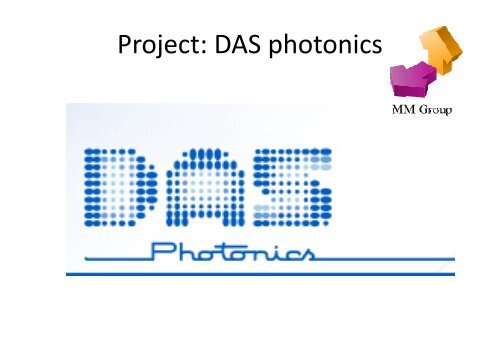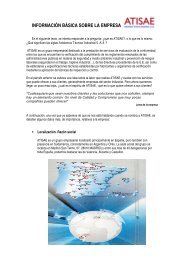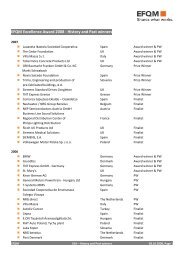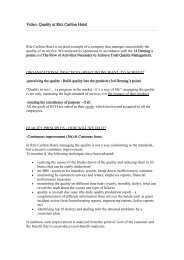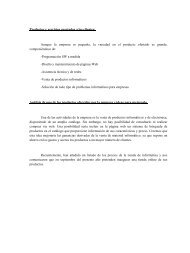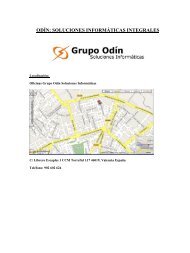Project: DAS photonics - Universidad Politécnica de Valencia
Project: DAS photonics - Universidad Politécnica de Valencia
Project: DAS photonics - Universidad Politécnica de Valencia
- No tags were found...
Create successful ePaper yourself
Turn your PDF publications into a flip-book with our unique Google optimized e-Paper software.
<strong>Project</strong>: <strong>DAS</strong> <strong>photonics</strong>
Description of the company• What does it do?<strong>DAS</strong> Photonics S.L. is a spin-off company from the<strong>Valencia</strong> Nano<strong>photonics</strong> Tecnology Center (NTC),<strong>Universidad</strong> Politécnica <strong>de</strong> <strong>Valencia</strong>, whose mission isto exert the European lea<strong>de</strong>rship in photonictechnology and system <strong>de</strong>velopment in the areas of:• Defense and Security• Avionics• Satellite• Telecommunications
Description of the company• Localisation :
Description of the company• History:“Market needsproducts…Not only basetechnologies”Javier Martí in 2005
Description of the company• History:Why don´tcreate a newcompany?
Description of the company• History:Then they started to offerreal solutions totechnological problems.
Description of the company• Objectives:To offer photonic <strong>de</strong>vices and systems thatmassive production companies don´t <strong>de</strong>signWhy?Because they can´t offer such low prices asthem
Description of the company• What can photonic <strong>de</strong>vices offer us?WeighSizeSpeedPowerneeds
Works and services offered to clients1.Digital ReceiversBased on proprietary photonic technology, high performance Digital Receivers<strong>de</strong>veloped at <strong>DAS</strong> Photonics go far beyond the performance of their electroniccounterparts in terms of bandwidth, dynamic range, …These <strong>de</strong>vices offer extremely interesting applications, especially in the fields ofelectronic warfare and next-generation Ultra Wi<strong>de</strong> Band (UWB) networks.
Works and services offered to clients2.Optical BeamformingOptical beamforming networks for phased-array antennas that exploit advantages ofphotonic technology (such as large bandwidth, fast beam switching, low size andweight, low power consumption, immunity to EMI and high parallelism) todynamically reconfigure their radiation patterns.Several prototypes (hybrid and integrated) have been <strong>de</strong>veloped, based on optical<strong>de</strong>lay lines and photonic integrated <strong>de</strong>vices.This kind of antennas is extremely attractive for satellite applications, as well as forhigh-resolution radar systems.
Works and services offered to clients3.Radio-over-fiber links for remote antennasHigh-performance optical links (high SFDR, low loss,large bandwidth) for interconnecting:•central and remote units in radar systems an<strong>de</strong>lectronic warfare receivers•central stations and base stations for the distibution ofmicrowave signals (WiMAX, UMTS,...) intelecomunication access networksThese optical-fibre links soften the localizationrequirements of the radiating elements and processingand frequency-converting systems, so that the opticalfibre transports the signals on the frequency bands thatare received (or transmitted) directly from theantennas.Their main application fieds are telecom, highresolutionradar systems and electronic warfare.
Works and services offered to clients4.Photonic nanostructuresSpecific <strong>de</strong>signs of nanostructures manufactured on diverse materials(semiconductors, polymers, metals,…) for applications of wavelength filtering, slowwaves, high-dispersive elements, coupling optimization and adaptation of refractivein<strong>de</strong>xes,…These nanostructures are of special interest for optical sensors and photonicprocessing <strong>de</strong>vices.
Works and services offered to clients5.High-performance telecommunication systems and <strong>de</strong>vicesInnovative cutting-edge-technology systems and <strong>de</strong>vices oriented towardstelecommunication applications, both at the core network and the access segment.Our <strong>de</strong>signs encompass products at system level as well as the fabrication ofcomponents and <strong>de</strong>vices for third-party products, through extensive expertise onfields such as microwave <strong>photonics</strong>, high-speed optical processing andmicro/nanofabrication technologies and processes.
Works and services offered to clients6.Optical Interconnects<strong>DAS</strong> Photonics <strong>de</strong>velops optical solutions for interconnecting electronic systems atvery high speed, based on different photonic technologies, oriented towards multipleapplication scenarios (board-to-board, system-to-system,…).Advanced computing, storage networks, or space systems are examples of the wi<strong>de</strong>range of applications targeted by these Optical Interconnect technologies.
Description of the company• Organization structure:Director : Javier MartiTOTAL:30 peopleDefenseAvionics3 divisions+Operation responsible+Technology OperatorSatelites
Description of the company• Competitors:Selex (Italy)+Thales (France)
10 Operations Management Decisions• Let's see how the company works:
Goods & service <strong>de</strong>sign• Das <strong>photonics</strong> works in theconception of components to <strong>de</strong>liverto clients (which are not commoncustomersbut companies).• These components are used for<strong>de</strong>fense, satelites and other very highlevel telecommunication areas.• For that reason, they have to be to<strong>de</strong>sign the smallest possible and theirweight is to be the lightest possible.• Most of the time, light is used to• Most of the time, light is used tovehicule this information. (light hasno weight!)
• Quality is the top priority ofDas phontonics.• The reason is simple, not onlyhas the customer to besatisfied, but also any smallerror could lead to themalfunction of thecomponent.• Due to the sectors in whichdas <strong>photonics</strong> works, whichare <strong>de</strong>fense, security and fibretransmission, the quality is ofthe upmost importance.Quality
Process & capacity <strong>de</strong>sign• The company is still growingactually.But due to its recentcreation, process and capacity <strong>de</strong>signare still evolving and not really longtermsituations at the moment.This year: 1 Mi €• Yet, different areas have their properscientist. An interview of one of themenlighted this question:– The company works with aperpendicualar system. Imaginetwo rows, one vertical andhorizontal. One is of the<strong>de</strong>cisions and the other oftechnologies. The intersection ofthem makes the company works.
Location selection• The company is located in thebest area of <strong>Valencia</strong>, in Spain.• They are in the university ofpolytechnica of <strong>Valencia</strong> andlinked to some other nanotechnologycompanies.• As it is growing, recruting somepotencial and talented newworkers is also a priority. Andstu<strong>de</strong>nts as of those from Telecoare first choices.
Layout <strong>de</strong>sign• The layout <strong>de</strong>sign has not changed since the begining and can be asubject of interest.• The blue color evocates the future and technologies.• The <strong>de</strong>sign of their website is clear and easy to use. As their componentshave to be.• Futhermore, their name Das Photonics is enough to guess that they areworking on light use, the area of future.
Human resource and job <strong>de</strong>sign• Starting firts with 5 peopleas a project, Das<strong>photonics</strong> has sucee<strong>de</strong>d ingrowing quickly.• In only 3 years (from 2005to 2008), more than 20people have arrived. Allqualified and young anddynamic.
Supply-chain management• Das Photonics is its own distributor• Yet It also uses its link with thenanotechnologic center to create newcontracts
Inventory• Das <strong>photonics</strong> does not need alot of raw materials: Theircomponents have to be smalland the lightest possible.• As a consequence, verypreciserobots, of the area ofthe nanotechnlogy, arenee<strong>de</strong>d and are furnished bySpain.• Optical systems to transportlight among materials are alsoimportant.
Scheduling• This is the strong point of DasPhotonics.• Using its perpendicular system,projects are created, proposedand accepted.• Their high investment in R&Dallows them to make somediscoveries, and to propose themin the correct area.• An example is the discovering of• An example is the discovering ofinvisible materials which can beused in <strong>de</strong>fense.
Maintenance• Maintenance is not a problem for das <strong>photonics</strong>.• On the left hand, they are evolving very importantly and they keepgetting bigger. They received a price for "Empre<strong>de</strong>dor en Telcos"last year.• On the other hand, their investment in R&D is going higher everyyear and shows how powerful this company is getting.
Quality ToolsBrainstorming&Ishikawa diagram
Quality ToolsThe most useful tools are:1. Brainstorming2. The Ishikawa diagram (or fishbone diagramor also cause-and-effect diagram)
1. BrainstormingQuality Tools1. Is a group creativity technique <strong>de</strong>signed to generate a large number ofi<strong>de</strong>as for the solution to a problem. The method was first popularized inthe late 1930s by Alex Faickney Osborn, an advertising executive and oneof the foun<strong>de</strong>rs of BBDO, in a book called Applied Imagination. Osbornproposed that groups could double their creative output by using themethod of brainstorming.2. Is wi<strong>de</strong>ly used, but there is limited agreement on the <strong>de</strong>tail of how it is tobe done. The name is often used for a general collection of thoughtswithin a group, whether it is creative or simple collation of known facts.Selection, often through Voting, is also often consi<strong>de</strong>red to be a part ofBrainstorming.
Quality Tools1. Brainstorminga) Useful situationes:• when new i<strong>de</strong>as are required, to generate a large list ofpossibilities,• when a solution to a problem cannot be logically <strong>de</strong>duced,• when information about a problem is confused and spreadacross several people, to gather the information in one place• The creative synergy of a Brainstorming session is also usefulin helping a team bind together
Quality Tools1. Brainstormingb) Steps of using brainstorm:• Start with a clear and open statement of the problem that you want to address.• Appoint a facilitator to organize and run the Brainstorming meeting. Look for a person who isskilled in facilitating, who has no strong opinions about the problem and who the potentialBrainstorming group will respect in that role. If possible, also appoint a recor<strong>de</strong>r.• Form a group of between five and eight people who may contribute to the problem. Look forcomplementary, rather than supplementary knowledge, to allow for the broa<strong>de</strong>st range ofinputs. Try to avoid including people who may antagonize or inhibit one another.• Lay out the meeting room with participants facing one wall, on which is a whiteboard orflipchart.• In the meeting, the facilitator focuses the group by <strong>de</strong>scribing the four rules of Brainstorming( No criticism or <strong>de</strong>bate, The sky is the limit, Quantity rather than quality, Mutate andcombine),• Start generating i<strong>de</strong>as, making sure that everyone can contribute.
Quality Tools1. Brainstormingb) Steps of using brainstorm:• As the i<strong>de</strong>as are suggested, the recor<strong>de</strong>r writes each one down on the whiteboard or flipchart, so thatthey are all in full view of the participants.• Ways to regenerate flagging i<strong>de</strong>as inclu<strong>de</strong>:– Build a private list of i<strong>de</strong>as beforehand, and dip into it when i<strong>de</strong>as run out or get stuck in a rut.– Stop for a while, and just look at the i<strong>de</strong>as generated so far.– Take a break. Rest the mind.– Have a 'wild i<strong>de</strong>a' session, where the main objective is to come up with outlandish i<strong>de</strong>as.– Improve on promising i<strong>de</strong>as by talking about, 'What I like about this i<strong>de</strong>a ... '.– Use one or more of the variations, below.• When there are no more i<strong>de</strong>as to add, discuss the listed i<strong>de</strong>as, looking to i<strong>de</strong>ntify the better i<strong>de</strong>as ratherthan eliminating those which are not so good. The i<strong>de</strong>as can be reviewed in the light of known constraints,such as time and cost, again looking positively for how they can be used within these constraints.• If there is no clear agreement on the best i<strong>de</strong>a, or if there is any chance of participants being reticent,i<strong>de</strong>ntify a voting system to <strong>de</strong>ci<strong>de</strong>
1. BrainstormingQuality Toolsc) Process of conducting a brainstorming session:
1. Brainstormingd) Conclusion:Quality ToolsBrainstorming is a popular method of group interaction in botheducational and business settings. Although it does not appear to provi<strong>de</strong>a measurable advantage in creative output, brainstorming is an enjoyableexercise that is typically well received by participants. Newer variations ofbrainstorming seek to overcome barriers like production blocking and maywell prove superior to the original technique. How well these newermethods work, and whether or not they should still be classified asbrainstorming, are questions that require further research before they canbe answered.
The cause-and-effect diagram is :Quality Tools2. The Ishikawa diagram• a method for analysing process dispersion. The diagram's purpose is to relate causes an<strong>de</strong>ffects. Three basic types: Dispersion analysis, Process classification and cause enumeration.Effect = problem to be resolved, opportunity to be grasped, result to be achieved. Excellentfor capturing team brainstorming output and for filling in from the 'wi<strong>de</strong> picture'. Helpsorganise and relate factors, providing a sequential view. Deals with time direction but notquantity. Can become very complex. Can be difficult to i<strong>de</strong>ntify or <strong>de</strong>monstrateinterrelationships.• the brainchild of Kaoru Ishikawa, who pioneered quality management processes in theKawasaki shipyards, and in the process became one of the founding fathers of mo<strong>de</strong>rnmanagement. The cause and effect diagram is used to explore all the potential or real causes(or inputs) that result in a single effect (or output). Causes are arranged according to theirlevel of importance or <strong>de</strong>tail, resulting in a <strong>de</strong>piction of relationships and hierarchy of events.This can help you search for root causes, i<strong>de</strong>ntify areas where there may be problems, andcompare the relative importance of different causes.
a) Appearance:Quality Tools2. The Ishikawa diagramMost Ishikawa diagrams have a box at the right hand si<strong>de</strong> in which is written the effect that is tobe examined. The main body of the diagram is a horizontal line from which stem thegeneral causes, represented as "bones". These are drawn towards the left-hand si<strong>de</strong> of thepaper and are each labeled with the causes to be investigated, often brainstormedbeforehand and based on the major causes listed above. Off each of the large bones theremay be smaller bones highlighting more specific aspects of a certain cause, and sometimesthere may be a third level of bones or more. These can be found using the '5 Whys'technique. When the most probable causes have been i<strong>de</strong>ntified, they are written in thebox along with the original effect. The more populated bones generally outline moreinfluential factors, with the opposite applying to bones with fewer "branches". Furtheranalysis of the diagram can be achieved with a Pareto chart.
Quality Tools2. The Ishikawa diagramb) Useful when:• investigating a problem, to i<strong>de</strong>ntify and select key problem causes toinvestigate or address,• the primary symptom (or effect) of a problem is known, but possiblecauses are not all clear,• working in a group, to gain a common un<strong>de</strong>rstanding of problem causesand their relationship,• we want to find other causal relationships, such as potential risks orcauses of <strong>de</strong>sired effects,• in preference to a Relations Diagram where there is one problem andcauses are mostly hierarchical (this will be most cases).
c) Steps of introducing:Quality Tools2. The Ishikawa diagram• Form a small team of people to work on the problem. I<strong>de</strong>ally, their knowledge and skills will becomplementary, to give a broad but expert group. If it has not been already <strong>de</strong>fined, meet first to <strong>de</strong>finethe key symptom or effect of the problem un<strong>de</strong>r scrutiny. Aim for a brief, clear phrase which <strong>de</strong>scribeswhat is happening to what, such as, 'Low sales of MkII Costor'. Make sure that only a single effect is<strong>de</strong>scribed, as this may result in several sets of causes.• Write down the key effect or symptom at the center-right of the page (or whiteboard or flipchart, if youare doing it in a group), and draw a spine horizontally from it to the left.• Draw the main cause area 'ribs' (typically around four to six), one for each of what appears to be theprimary cause areas. If these are uncertain, then the 'Four Ms' (Manpower, Methods, Machines andMaterials) provi<strong>de</strong> a good starting point, as illustrated in Fig. 1. In these gen<strong>de</strong>r-free days, an exactalternative is the four Ps (People, Processes, Plant and Parts).
c) Steps of introducing:Quality Tools2. The Ishikawa diagram• Use Brainstorming to build the diagram, adding causes or cause areas to the appropriate ribs or sub-ribs asthey appear.• If a cause appears in several places, show the linkage by using the same capital letter next to each linkedcause, as illustrated.• Beware of adding 'causes' which are actually solutions. These often are expressed as a negative; furtherconsi<strong>de</strong>ration may find a truer cause.• Beware also of things which are knock-on effects, rather than causes• Ways of finding more causes inclu<strong>de</strong>: Keep asking 'Why?‘, Look at the diagram without talking. Look forpatterns, Take a break. Do something to take your mind off your current line of thought, Involve otherpeople, especially those who have expertise in the problem areas, Leave the chart on the wall for a fewdays to let i<strong>de</strong>as incubate and encourage passers-by to contribute.• Discuss why the found causes are there. Look for and circle key causes which require further attention.Avoid having too many key causes, as this may result in <strong>de</strong>focused activities. If there is no clear agreement,use a Voting system.• Consi<strong>de</strong>r the key causes again. Are any more important than others? If so, put a second circle aroundthem, or put numbers next to them to show their relative priority.• If necessary, gather data to confirm key causes are real, and not just assumed. Repeat the process asnecessary.• Plan and implement actions to address key causes.
d) To build successfully:Quality Tools2. The Ishikawa diagram• Be sure everyone agrees on the effect or problem statementbefore beginning.• Be succinct.• For each no<strong>de</strong>, think what could be its causes. Add them tothe tree.• Pursue each line of causality back to its root cause.• Consi<strong>de</strong>r grafting relatively empty branches onto others.• Consi<strong>de</strong>r splitting up overcrow<strong>de</strong>d branches.• Consi<strong>de</strong>r which root causes are most likely to merit furtherinvestigation.
Optical Ethernet AdapterDesign of a new good :
Design of a new good
Design of a new good
Transmitter : SLEDDesign of a new good
Design of a new goodReceiver : PIN photodio<strong>de</strong>
Design of a new goodWhich services willour new opticalcard provi<strong>de</strong>?
DownloadDesign of a new good
Design of a new goodTv on pc and High <strong>de</strong>finition TV
Vi<strong>de</strong>o UploadDesign of a new good
VODDesign of a new good
VoIPDesign of a new good
GamingDesign of a new good
E-commerce
E-commerceCan we sell ourproducts all aroundthe World?
E-commerce• Thanks to e-commerce we can offer ourservices to customers that otherwise wouldn´tbe able to reach us.
E-commerce•It´s a great i<strong>de</strong>a….It´s a great i<strong>de</strong>a….But how does itwork?
E-commerce
Conclusions• Small companies like <strong>DAS</strong> <strong>photonics</strong> cansuceed but they need to create products thatothers don´t offer• They work over previous <strong>de</strong>mand, so it´s veryimportant that customers get what theywanted• As there are very few workers they need tocooperate to create new products.• E-commerce can help small companies tobecome popular and increase sells.
Cuestions?
<strong>Project</strong> bibliography• Webs:www.das<strong>photonics</strong>.comwww.google.eswww.wikipedia.es• Vi<strong>de</strong>os:http://vi<strong>de</strong>o.google.es/vi<strong>de</strong>oplay?docid=-6495793086073748338&q=das+<strong>photonics</strong>&total=5&start=0&num=10&so=0&type=search&plin<strong>de</strong>x=1&hl=eshttp://vi<strong>de</strong>o.google.es/vi<strong>de</strong>oplay?docid=-3896805254313361717&q=das+<strong>photonics</strong>&total=5&start=0&num=10&so=0&type=search&plin<strong>de</strong>x=0&hl=eshttp://vi<strong>de</strong>os.orange.es/vi<strong>de</strong>o/iLyROoaftwps.html%2520%2520


